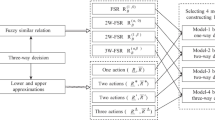Abstract
Knowledge-based modeling is a trend in complex system modeling technology. To extract the process knowledge from an information system, an approach of knowledge modeling based on interval-valued fuzzy rough set is presented in this paper, in which attribute reduction is a key to obtain the simplified knowledge model. Through defining dependency and inclusion functions, algorithms for attribute reduction and rule extraction are obtained. The approximation inference plays an important role in the development of the fuzzy system. To improve the inference mechanism, we provide a method of similarity-based inference in an interval-valued fuzzy environment. Combining the conventional compositional rule of inference with similarity based approximate reasoning, an inference result is deduced via rule translation, similarity matching, relation modification, and projection operation. This approach is applied to the problem of predicting welding distortion in marine structures, and the experimental results validate the effectiveness of the proposed methods of knowledge modeling and similarity-based inference.
Similar content being viewed by others
References
Atanassov, K.T., 1986. Intuitionistic fuzzy sets. Fuzzy Sets Syst., 20(1):87–96. [doi:10.1016/S0165-0114(86)80034-3]
Bustince, H., Burillo, P., 1996. Vague sets are intuitionistic fuzzy sets. Fuzzy Sets Syst., 79(3):403–405. [doi:10.1016/0165-0114(95)00154-9]
Chen, S.M., 1994. A weighted fuzzy reasoning algorithm for medical diagnosis. Dec. Support Syst., 11(1):37–43. [doi:10.1016/0167-9236(94)90063-9]
Chen, S.M., 1997. Bidirectional approximate reasoning based on interval-valued fuzzy sets. Fuzzy Sets Syst., 91(3): 339–353. [doi:10.1016/S0165-0114(97)86594-3]
Cornelis, C., Jensen, R., 2010. Attribute selection with fuzzy decision reducts. Inform. Sci., 180(2):209–224. [doi:10.1016/j.ins.2009.09.008]
Cornelis, C., Cock, M.D., Kerre, E.E., 2003. Intuitionistic fuzzy rough sets: at the crossroads of imperfect knowledge. Expert Syst., 20(5):260–270. [doi:10.1111/1468-0394.00250]
Cornelis, C., Deschrijver, G., Kerre, E.E., 2004. Implication in intuitionistic fuzzy and interval-valued fuzzy set theory: construction, classification, application. Int. J. Approx. Reas., 35(1):55–95. [doi:10.1016/S0888-613X(03)00072-0]
Deschrijver, G., Kerre, E.E., 2003. On the relationship between some extensions of fuzzy set theory. Fuzzy Sets Syst., 133(2):227–235. [doi:10.1016/S0165-0114(02)00127-6]
Dubois, D., Prade, H., 1990. Rough sets and fuzzy rough sets. Int. J. Gener. Syst., 17(2–3):191–209. [doi:10.1080/03081079008935107]
Fan, F., Li, J.Z., Gao, Z.A., 2008. Design of self-adaptive PID controller based on GA-vague sets. Comput. Eng. Appl., 44(29):99–101 (in Chinese). [doi:10.3778/j.issn.1002-8331.2008.29.027]
Feng, L., Wang, G.Y., 2010. Knowledge acquisition in vague objective information systems based on rough sets. Expert Syst., 27(2):129–142. [doi:10.1111/j.1468-0394.2010.00512.x]
Feng, Z.Q., Liu, C.G., 2012. On vague logics and approximate reasoning based on vague linear transformation. Int. J. Syst. Sci., 43(9):1591–1602. [doi:10.1080/00207721.2010.549579]
Gau, W.L., Buehrer, D.J., 1993. Vague sets. IEEE Trans. Syst. Man Cybern., 23(2):610–614. [doi:10.1109/21.229476]
Gong, Z.T., Sun, B.Z., Chen, D.G., 2008. Rough set theory for the interval-valued fuzzy information systems. Inform. Sci., 178(8):1968–1985. [doi:10.1016/j.ins.2007.12.005]
Gorzalczany, M.B., 1987. A method of inference in approximate reasoning based on interval-valued fuzzy sets. Fuzzy Sets Syst., 21(1):1–17. [doi:10.1016/0165-0114(87)90148-5]
Guan, Y.Y., Wang, H.K., 2006. Set-valued information systems. Inform. Sci., 176(17):2507–2525. [doi:10.1016/j.ins.2005.12.007]
Hai, X., Lei, Y.J., 2010. Intuitionistic fuzzy approximate reasoning based on weighted similarity measure. Comput. Eng. Des., 31(21):4678–4681 (in Chinese).
Jensen, R., Shen, Q., 2009. New approaches to fuzzy-rough feature selection. IEEE Trans. Fuzzy Syst., 17(4):824–838. [doi:10.1109/TFUZZ.2008.924209]
Kuncheva, L.I., 1992. Fuzzy rough sets: application to feature selection. Fuzzy Sets Syst., 51(2):147–153. [doi:10.1016/0165-0114(92)90187-9]
Liang, J.R., 2007. The research of vague-rough sets based on triangle model. Comput. Sci., 34(10):185–187 (in Chinese). [doi:10.3969/j.issn.1002-137X.2007.10.047]
Ou, X.Y., Zhang, F.J., Wei, Y.B., 2009. Vague set fuzzy reasoning mechanism based on the temperature control system design. J. Qiongzhou Univ., 16(5):29–31 (in Chinese). [doi:10.3969/j.issn.1008-6722.2009.05.010]
Pawlak, Z., 1982. Rough sets. Int. J. Comput. Inform. Sci., 11(5):341–356. [doi:10.1007/BF01001956]
Qiu, W.G., 2006. Rough vague sets based on general binary relation. Comput. Sci., 33(2):191–192 (in Chinese). [doi:10.3969/j.issn.1002-137X.2006.02.054]
Raha, S., 2008. Similarity based approximate reasoning: fuzzy control. J. Appl. Logic, 6(1):47–71. [doi:10.1016/j.jal.2007.01.001]
Shen, Q., Chouchoulas, A., 2000. A modular approach to generating fuzzy rules with reduced attributes for the monitoring of complex systems. Eng. Appl. Artif. Intell., 13(3):263–278. [doi:10.1016/S0952-1976(00)00010-5]
Turksen, I.B., 1986. Interval valued fuzzy sets based on normal forms. Fuzzy Sets Syst., 20(2):191–210. [doi:10.1016/0165-0114(86)90077-1]
Turksen, I.B., Zhao, Z., 1988. An approximate analogical reasoning based on similarity measures. IEEE Trans. Syst. Man Cybern., 18(6):1049–1056. [doi:10.1109/21.23107]
Wan, S.P., 2010. Survey on intuitionistic fuzzy multi-attribute decision making approach. Contr. & Dec., 25(11):1061–1066 (in Chinese).
Wang, D.G., Meng, Y.P., Li, H.X., 2008. A fuzzy similarity inference method for fuzzy reasoning. Comput. Math. Appl., 56(10):2445–2454. [doi:10.1016/j.camwa.2008.03.054]
Yang, H.C., Chen, H., 2011. Intuitionistic fuzzy approximate reasoning based on intuitionistic fuzzy operation. Appl. Res. Comput., 28(1):102–104 (in Chinese). [doi:10.3969/j.issn.1001-3695.2011.01.027]
Yang, L.J., Wang, Y.L., 2010. A new similarity measure and its application to pattern recognition. J. Yunnan Univ. Natl., 19(1):71–73 (in Chinese). [doi:10.3969/j.issn.1672-8513.2010.01.018]
Yeung, D.S., Tsang, E.C.C., 1997. A comparative study on similarity-based fuzzy reasoning methods. IEEE Trans. Syst. Man Cybern. B, 27(2):216–227. [doi:10.1109/3477.558802]
Zadeh, L.A., 1965. Fuzzy sets. Inform. Contr., 8(3):338–353. [doi:10.1016/S0019-9958(65)90241-X]
Zhang, Q.S., Jiang, S.Y., 2010. System decision making method based on vague bidirectional approximate reasoning. Comput. Sci., 37(4):219–223 (in Chinese). [doi: 10.3969/j.issn.1002-137X.2010.04.055]
Zheng, C.H., Li, T.F., Gui, J.Z., 2008. Study on aeroengine fault diagnosis based on similarity measures between vague sets. Aeronaut. Comput. Techn., 38(2):34–36 (in Chinese). [doi:10.3969/j.issn.1671-654X.2008.02.009]
Author information
Authors and Affiliations
Corresponding author
Additional information
Project supported by 2013 Comprehensive Reform Pilot of Marine Engineering Specialty (No. ZG0434)
Electronic supplementary materials: The online version of this article (http://dx.dor.org/10.1631/jzus.C1300370) contains supplementary materials, which are available to authorized users
Electronic supplementary material
Rights and permissions
About this article
Cite this article
Feng, Zq., Liu, Cg. & Huang, H. Knowledge modeling based on interval-valued fuzzy rough set and similarity inference: prediction of welding distortion. J. Zhejiang Univ. - Sci. C 15, 636–650 (2014). https://doi.org/10.1631/jzus.C1300370
Received:
Accepted:
Published:
Issue Date:
DOI: https://doi.org/10.1631/jzus.C1300370
Key words
- Knowledge modeling
- Interval-valued fuzzy rough set
- Similarity-based inference
- Welding distortion prediction




